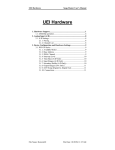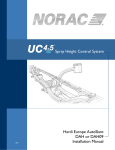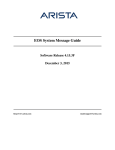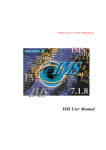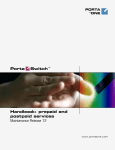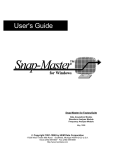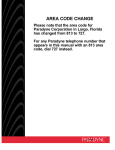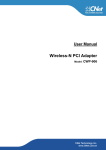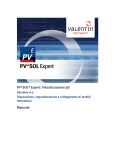Download SnapFense: - Snap Defense
Transcript
SnapFense –Interoperable Secure Network SnapFense: Managed and Interoperable Secure Network Solution © Copyright by Snap Defense Systems LLC, 2002-2006 All rights reserved 1 SnapFense-Interoperable Secure Network Snap Defense Systems reserves the right, without notice, to make changes in equipment design or specifications. Snap Defense Systems will make every effort to provide accurate and reliable information. However, Snap Defense Systems assumes no responsibility for its use or for rights of third parties, which may result from its use. Any representations in this document concerning performance are for informational purposes only and are not warranties of future performance either express or implied. Snap Defense Systems standard limited warranty stated in its sales contracts, order confirmation form or any other document, is the only warranty offered by Snap Defense Systems. This document contains proprietary information. Neither this document nor said proprietary information, nor any part thereof, shall be published, reproduced, copied, disclosed, or used for any purpose other than the review and consideration of this material without written approval from Snap Defense Systems. Trademarks Snap Defense Systems, SNAP, Snapfone, Snapcell, Snapsoft, Snaptrunk, Snapmaster, Snapgate, SnapMesh, SnapFence, SnapZone, Snaploader, and STconsole are trademarks of Snap Defense Systems LLC. Windows and Microsoft TM are trademarks of Microsoft Corporation, Dialogic is a trademark of Dialogic Corporation. All terms mentioned in this document that are known to be trademarks or service marks have been appropriately capitalized. Use of a term in this document should not be regarded as affecting the validity of any trademark or service mark. All trademarks mentioned hereby belong to their respective owners. Snap Defense Systems LLC 2 SnapFense –Interoperable Secure Network Table of Contents 1 THE CONCEPT ...............................................................................................................................5 2 SNAPFENSE MAIN COMPENENTS................................................................................................6 2.1 2.1.1 2.2 2.3 2.4 2.5 2.6 2.6.1 Call Flow Explained .......................................................................................................................6 SnapFense subscriber calls a non-subscriber .................................................................................7 Non-subscriber calls a SnapFense subscriber ............................................................................8 SnapFense subscriber to another SnapFense subscriber ........................................................10 Calls between Snaptrunks...........................................................................................................11 Digital Encryption ........................................................................................................................12 Snapcrypt .....................................................................................................................................12 Snapcrypt Features........................................................................................................................12 3 SNAPFENSE ELEMENTS .............................................................................................................13 3.1 3.1.1 3.1.2 3.2 3.2.1 3.2.2 3.2.3 3.3 3.3.1 3.4 3.4.1 Snaptrunk - Secure Communications Gateway..........................................................................13 Description ....................................................................................................................................13 Snaptrunk as a Network Switch......................................................................................................14 STconsole – Management Console.............................................................................................15 Description ....................................................................................................................................15 Features ........................................................................................................................................15 Remote Connection .......................................................................................................................15 Snapsoft Security Software.........................................................................................................16 Snapsoft Features .........................................................................................................................16 Snapfone ......................................................................................................................................17 Snapfone Features ........................................................................................................................17 4 SNAPFENSE SYSTEM FEATURES ..............................................................................................18 4.1 4.1.1 4.2 4.3 4.4 4.4.1 4.4.2 4.5 Lawful Interception (LI) & CALEA Compliance ..........................................................................18 Call Flow with LI (Example)............................................................................................................18 Direct Dialing ...............................................................................................................................18 Call Drop Errors & Normal releases............................................................................................19 Alarms 19 Failure Situations ...........................................................................................................................19 Alert Mechanisms ..........................................................................................................................19 Secure Data Modem Support - Option ............................................... Error! Bookmark not defined. 5 APPENDIX A.................................................................................................................................20 6 SNAPFENSE SYSTEM SPECIFICATIONS ...................................................................................21 6.1 6.1.1 6.2 6.2.1 6.2.2 6.2.3 6.2.4 6.2.5 6.2.6 6.3 6.3.1 6.3.2 6.3.3 6.3.4 6.3.5 6.3.6 Snaptrunk Hardware ....................................................................................................................21 Snaptrunk Specifications................................................................................................................21 Snaptrunk Software .....................................................................................................................21 Vocoder .........................................................................................................................................21 Encryption (FIPS compliant)...........................................................................................................21 Modem 21 V110…… .......................................................................................................................................21 V32…… .........................................................................................................................................21 Fax Relay ......................................................................................................................................21 Snapfone Hardware .....................................................................................................................22 Approvals ......................................................................................................................................22 Supported Line Parameters ...........................................................................................................22 DTMF Signaling .............................................................................................................................22 Line Interface Parameters (DAA) ...................................................................................................22 Phone Interface Parameters (SLIC) ...............................................................................................22 Miscellaneous ................................................................................................................................22 3 SnapFense-Interoperable Secure Network 6.4 6.4.1 6.4.2 6.4.3 6.4.4 6.5 6.5.1 6.5.2 6.5.3 6.5.4 6.5.5 Snapfone Software ......................................................................................................................23 Modem 23 Vocoder .........................................................................................................................................23 Encryption (FIPS compliant)...........................................................................................................23 Fax Relay ......................................................................................................................................23 Snapsoft Software .......................................................................................................................23 V110…… ................................................................................................................................ ……23 V32….. 23 Fax Relay ......................................................................................................................................23 Vocoder .........................................................................................................................................23 Encryption (FIPS compliant)...........................................................................................................23 7 TERMINOLOGY ............................................................................................................................24 4 SnapFense –Interoperable Secure Network 1 The Concept Snap Defense Systems has developed a robust, scalable and cost-effective interoperable encryption solution into a single security platform. The company’s architecture is; SNAP (Secure Network Access Platform) which is a point-tomultipoint total security solution. It is the only unified, interoperable, and secure telephony communications platform available for both government and commercial applications. The unique architecture is revolutionary because the main security functions are deployed, managed and enforced through a network-based security gateway versus other products whose primary security functions are end-user controlled at the endpoints. Through the network-based concept we can provide security to any SNAP subscriber even when only one party has an encryption device. This allows the subscriber to have security at all times instead of only when both parties have a similar encryption device. The SnapFense total security solution provides enterprise users with security features, such as authentication, access control, user calling restrictions, VPN encryption, call destination encryption and point-to-any-point secured communications. The solution also uses a variety of off-the-shelf devices for transparently securing the user’s end-point’s voice, fax or data. The hub known as the Snaptrunk is connected to E1/T1 digital trunks. The Snapfone is connected through POTS lines. Both the Snapcell & Snapsoft are used for connecting through wireless carriers. SnapFense Main Components 5 SnapFense-Interoperable Secure Network 2 SnapFense Main Components The main components of the SnapFense solution are: 1) Network EquipmentSnaptrunk, 2) End-points- Snapfone, Snapcell and Snapsoft, and 3) Management Software - STconsole. For the purposes of IWN: Snapfone & Snapsoft will be the preferred end-points. ♦ The Snapfone, Snapcell and Snapsoft are encryption end-point units. The Snapfone plugs in between a telephone (or a fax machine) and the RJ-11 line port. The Snapsoft is an embedded software application that provides encrypted voice, text and data security on a handheld mobile device. The Snapcell is a hardware plug-in for Sony-Ericsson phones that provides voice security. ♦ The Snaptrunk is a multi-line encryption gateway connected to the PSTN via digital interfaces such as E1/T1 ISDN PRI trunks. Installed at a point-ofpresence, the Snaptrunk encrypts/decrypts communications to/from the endpoints. It acts as the hub for all network activity. ♦ The STconsole is an enterprise management software for performing remote management, enforcing policies to end-points and maintaining a database of all subscribers within the SnapFense network. Figure 1 SnapFense- Interoperable Secure Network (ISN) 2.1 Call Flow Explained 6 SnapFense –Interoperable Secure Network Figure 1 pictures the SnapFense solution for Interoperable Secure Network (ISN) ♦ All calls for subscribers of the SnapFense (ISN) are logically routed through one or more Snaptrunks depending on user definitions. ♦ All communications between a Snaptrunk and a End-point will always be secured, regardless to which side is equipped with a Snapfone. ♦ The End-Points provide the necessary information to the Snaptrunk for user authentication, and Snaptrunk is the component that analyzes this information and carries out the necessary switching and routing to establish an End-to-End secure call or a Secure-to-Network only connection. ♦ The procedure for call-setup, routing and access depend on which of the two parties is a subscriber of the SnapFense (ISN). There are three different possible scenarios for Secure Call Setup: 1) Subscriber calls a non-subscriber; 2) Non-subscriber calls a subscriber’s secure number, 3) Two subscribers call each other. Note: The Gray colored areas in the tables 1-4 relate to procedures taking place between the Snaptrunk and the Snapsoft or Snapfone during different stages of the secured channel setup. See “Appendix A” for additional call flow diagram. 2.1.1 SnapFense subscriber calls a non-subscriber For convenience, we identify this scenario as a User – to – Non-User Call. Diagram 1illustrates the step-by-step interactions among the SnapFense components. The technical explanation of each phase is in greater detail within Table 1 User-to-Non-User Call Explained. Diagram 1 User-to-Non-User Call Flow User 1 2 3 SNAPtrunk DB DESTINATION User-to-Non-User Call Evoked Authentication, Modem Synchronization, Secured Session Establishing Transmitting Dialing Information Analyzing 4 Number Calling DestinationNumber 5 6 ROUTING Table 1 User-to-Non-User Call Explained 1 SnapFense user wants to make a secure call using an encryption end-point (Snapfone, Snapcell, or Snapsoft). The user dials the destination number. The end-point transparently dials to the Snaptrunk using 7 SnapFense-Interoperable Secure Network a dedicated gateway telephone number that is preprogrammed into the software or hardware encryption end-point by their administrator. While the unsecure channel is being converted into an encrypted channel, the actual destination number in stored in the end-point’s memory. For Snapsoft and Snapcell on GSM networks: The mobile phone will communicate with carrier’s switch and through AT commands a request for CSD bearer services is made. The commands can be for a transparent or non-transparent data call using a bit rate of 9600 bps. In the signaling phase there is a request from the IWF (inter-working function) to allocate a V.32 or V.110 modem session. The call from the IWF is then routed to the Snaptrunk through PRI line (The Snaptrunk accepts the call and uses the correct modem to establish a data channel connection). All voice and encryption processes will be transparent to network. 2 3 4 5 6 The Snapfone, Snapcell or Snapsoft and the Snaptrunk start a session based on the v.32/ v.110 protocol or a regular modem session followed by a key exchange. Upon successful synchronization, key exchange, and end-point authentication, within the database, the Snaptrunk initiates an encrypted channel between itself and the subscriber’s end-point device. The channel is now encrypted. The end-point device transmits the actual destination number to the Snaptrunk. The Snaptrunk queries the internal user database to determine whether the destination number is registered to a SnapFense user, as well as the privileges and credentials of the user. In this example, the destination is not registered to a SnapFense user and the user is authorized to make outgoing calls to non-users. The Snaptrunk generates an outbound call using the destination number on a different channel on the E1 trunk. Both channels are logically routed and connected. The user’s access network will be totally secure. The subscriber is notified visually and audibly of the security level achieved prior before both parties can start communicating. Note: The system compresses voice to 8 Kbit/sec (G-729A) for Snapfone and 6.4Kbit/sec (G723.1) for Snapcell & Snapsoft PDA while retaining a high voice quality (toll quality) and uses fax relay for fax transmissions. The initial call setup time is about 6 to 7 seconds. The round trip delay is less than 100msec for Snapfone and about 400msec for Snapcell or Snapsoft PDA. The voice is toll-quality over both wireless and wired networks. 2.2 Non-subscriber calls a SnapFense subscriber For convenience, we identify this scenario as a Non-User-to-User call. Diagram 2 Non-User-to-User Call Flow, accompanied by Table 2 Non-User-toUser Call explained, illustrates this scenario. 8 SnapFense –Interoperable Secure Network Caller 1 SN APtrunk DB User Non-User to User call initiated Analyzing 2 Numbe 3 Calling Destination Number 4 Authentication, M odem Synchronization, Secured Session Establishing 5 RO UTIN G Diagram 2 Non-User-to-User call flow Table 2 Non-User-to-User call explained The secure number of a SnapFense subscriber is dialed. The call is routed to a Snaptrunk first.. The Snaptrunk queries the internal user database to determine whether the destination number is registered to a SnapFense user, as well as the privileges and credentials of the user. The Snaptrunk dials the real destination number on different channel on the E1 or T1 trunk. The Snaptrunk and the destination end-point device (Snapfone, Snapcell or Snapsoft) begin a modem session followed by key exchange. Upon successful synchronization, key exchange, and user authentication within the internal Snaptrunk database, the Snaptrunk initiates an outbound encrypted channel between itself and the end-point device (Snapfone Snapcell or Snapsoft). Both channels are logically routed and connected. The user’s access network will be totally secure. The subscriber is notified visually and audibly of the security level achieved prior before both parties can start communicating. 1 2 3 4 5 9 SnapFense-Interoperable Secure Network 2.3 SnapFense subscriber to another SnapFense subscriber This scenario describes a User-to-User call. Diagram 3: User-to-User call flow illustrates the secured connections on both segments from a subscriber to the Snaptrunk, and from the Snaptrunk to another subscriber. U ser 1 SN A Ptrunk D atab ase U ser-to-User call initiated 2 Authentication, M odem Synchronization, Secured Session Establishing 3 Transm itting D estination N um ber Analyzing N um ber 4 5 Calling Destination N um ber 6 A uthentication, M odem Synchronization, Secured Session Establishing 7 U ser R O U TIN G Diagram 3 User -to-User call flow Table 3 User-to-User call explained 1 SnapFense user makes a secure call using an encryption end-point (Snapfone, Snapcell, or Snapsoft). The user dials the destination number. The end-point transparently dials to the Snaptrunk using a dedicated gateway telephone number that is preprogrammed into the software or hardware encryption end-point by their administrator. While the unsecure channel is being converted into an encrypted channel, the actual destination number in stored in the end-point’s memory. For Snapsoft and Snapcell on GSM networks: The mobile phone will communicate with carrier’s switch and through AT commands a request for CSD bearer services is made. The commands can be for a transparent or non-transparent data call using a bit rate of 9600 bps. In the signaling phase there is a request from the IWF (inter-working function) to allocate a V.32 or V.110 modem session. The call from the IWF is then routed to the Snaptrunk through PRI line (The Snaptrunk accepts the call and uses the correct modem to establish a data channel connection). All voice and encryption processes will be transparent to network. 2 The Snapfone, Snapcell or Snapsoft and the Snaptrunk initiate a session based on the v.32/ v.110 protocol or a regular modem session followed by a key exchange. Upon successful synchronization, key exchange, and end-point authentication (within the database) the Snaptrunk initiates an encrypted channel between itself and the subscriber’s end-point device. The channel is now encrypted. The end-point device transmits the actual destination number to the Snaptrunk. The Snaptrunk queries the internal user database to determine whether the destination number is registered to a SnapFense user, as well as the privileges and credentials of the user. The Snaptrunk generates an outbound call to the end-point device using the real number on a different channel on the E1 or T1 trunk. The Snapfone, Snapcell or Snapsoft and the Snaptrunk initiate a session based on the v.32/v.110 protocol or a regular modem session followed by a key exchange. Upon successful synchronization, key exchange, and end-point authentication, within the database, the Snaptrunk initiates an encrypted channel between itself and the subscriber’s end-point device at the destination. Both channels are logically routed and connected. The user’s access network will be totally secure. The subscriber is notified visually and audibly of the security level achieved prior before both parties can start communicating. 3 4 5 6 7 10 SnapFense –Interoperable Secure Network 2.4 Calls between Snaptrunks This scenario describes a User-to-User Call with two different Snaptrunks in two different locations (please refer to Figure 1, Appendix A, Diagram 4) where two Snaptrunks are connected to PBX’s. In this example the Snaptrunks performs two duties; as a security gateway and telecommunications firewall by protecting the PBX’s from brute-force and rouge modem attacks. The subscribers in this scenario do not have an end-point device (Snapsoft, Snapcell or Snapfone) The synchronization occurs between two Snaptrunks. The connection between both facilities will be secured every time a subscriber calls from/to either facility. Diagram 4 Snaptrunk - to - Snaptrunk Call Flow SNAPtrunk-A 1 SNAPtrunk-B Trunk-to-Trunk call initiated Authentication, Synchronization, Secured Session Establishing 2 3 ROUTING 4 Table 4 Snaptrunk to Snaptrunk call Explained 1 User dials the destination number. 2 Snaptrunk-A encrypts the call and sends it to PSTN secured. 3 The channel is now secure. 4 Snaptrunk-B accepts the call, synchronizes with Snaptrunk-A, and decrypts the call. 5 Other user accepts the call. Note: The Snaptrunk operates the E1/T1 interface as a 30/24 individual time slot of voice information. The output port leaving one destination is designated to the input port of other Snaptrunk. This occurs as a 64K encryption/decryption session after the ADPCM compression. The initial call setup time is approximately 1.5 seconds. Round trip delay is less than 40msec. The transport link between Snaptrunks is secured. Internet protocol for data call is currently not supported. It will be available as an upgrade. 11 SnapFense-Interoperable Secure Network 2.5 Digital Encryption The SnapFense total security architecture implements both public and high fidelity private key encryption technologies. The 3DES/AES and 1024-bit Diffie-Hellman algorithms constitute the core of the current encryption process. The 1024-bit Diffie-Hellman algorithm is used for key exchange and authentication at the beginning of a session. The system implements the 3DES/AES algorithm for encrypting the actual session. New keys are drawn for each session. The flexible design allows implementation of other encryption algorithms as an option. The SnapFense system encryption level can be easily upgraded, even remotely. 2.6 Snapcrypt Snapcrypt enables rapid and robust implementation of security applications in embedded systems. Powered by industry-standard cryptographic algorithms and optimized for mobile applications. Snapcrypt addresses security requirements by offering cryptographic libraries optimized for Texas Instruments DSP and for ARM RISC processors. Snapcrypt features a small memory footprint combined with exceptional efficiency that minimizes the impact on battery life. Snapcrypt provides a complete suite of industry standard cryptographic libraries. These cryptographic libraries enable application developers to easily integrate encryption, hash functions, digital signatures and key exchange mechanisms into embedded systems. Snapcrypt core engines are FIPS approved which means that the protocols, algorithms and key management processes meet and/or exceed government standards for protecting up to the most sensitive user information. Snap Defense Systems also offers software which can create interoperability among different devices. This, in turn, creates operational efficiencies and reduced capital expenditures when procuring secure communication systems. Snapcrypt provides various private and public key encryption algorithms including all algorithms required by the IPSec standard, such as DES, 3DES and AES for symmetric encryption, key exchange protected by ElGamal, RSA and DiffieHellman, MD5 and SHA-1 hash functions, along with their keyed versions (HMAC), RSA, ECC and DSA for digital signatures. 2.6.1 Snapcrypt Features 12 Advanced cryptographic cores approved by NIST DSP optimization with batter-saving technology High performing and efficient engines Small footprint design Fast turn around to market, greater return on investment SnapFense –Interoperable Secure Network 3 SnapFense Elements 3.1 Snaptrunk - Secure Communications Gateway Figure 2 Snaptrunk 3.1.1 Description The Snaptrunk is a security encryption gateway with enterprise management software. It is connected via digital circuits (T1/E1 or ISDN) and the PBX. Snaptrunk is a security breakthrough in communications. It shifts the security administrative controls to the network level, rather than the individual user. This allows for greater continuity across the enterprise, improved compliance with security policies and centralization of administrative controls. For example, Snaptrunk includes central management functionality capable of supporting and managing groups of secured networks and performing management services, such as authentication, configuration, alarm, statistics, user profiling, auditing, call detail reports (CDR), remote upgrading and more. Snaptrunk is also compatible with all major PBX manufactures. Snaptrunk is an effective tool that enforces and monitors corporate security policy by detecting, logging and controlling all inbound and outbound network activity based on user-defined, automated security policies. It protects enterprise networks, phone systems and other critical infrastructure from back-door and other external attacks through the Public Switched Telephone Network (PSTN). Additionally, the Snaptrunk also securely connects users at endpoints using Snapsoft, Snapcell, and Snapfone with each other. The Snaptrunk’s super-advanced gateway architecture is based on military technology used for protecting battlefield and military intelligence. Snaptrunk is completely transparent to the end-user, allowing a secure call to be placed in the exact same manner as a regular call. Snaptrunk is also capable of securing conference calls and with its patented multipoint switching technology can protect remote users from any location regardless of connectivity (analog, digital or cellular). A single Snaptrunk can support up to six E1/T1 interfaces, securing up 180 concurrent secure calls which can typically secure up to 1800 users. Multiple Snaptrunks can be rack-mounted for additional capacity. 13 SnapFense-Interoperable Secure Network 3.1.2 Snaptrunk as a Network Switch All the digital trunks at a SnapFense node should be of the same range of telephone numbers (“node range”). Any number dialed within this range reaches a Snaptrunk at the node. The routing to one trunk or the other is dependent on the Telecom Operator’s algorithm and configuration. A call can reach a Snaptrunk for one of the following reasons: 1) A user initiates a secure call: Snapfones, Snapcells, and Snappsofts can be registered to one or more Snaptrunks. The user never dials the Snaptrunk’s Security Center telephone number as the units are preconfigured to dial a specific telephone number within the node’s range of numbers. 2) A non-user dials a number associated with a subscriber: The “association” can be one of the following: 14 Using Secure Numbers: The administrator supplies each user with a unique secure virtual number within the range of the SnapFense node. When a call is placed to a secure virtual number the Snaptrunk retrieves the real number from the database and dials it generates an outbound secure session. Using a dedicated Service Provider prefix: The telecom operator may provide the organization with a dedicated prefix. Any call starting with this prefix will be routed to the associated Snaptrunk site. The Snaptrunk then removes the prefix from the dialed number, and dials the remaining digits for the secure call. SnapFense –Interoperable Secure Network 3.2 STconsole – Management Console STconsole interface 3.2.1 Description The SnapFense system architecture provides user-friendly enterprise management software; the STconsole. STconsole provides several administrative tools for managing all security aspects for registered subscribers of the SnapFense solution. STconsole is equipped to monitor each Snaptrunk’s status, call traffic, audit records, as well as enterprise policy enforcement, updating device parameters and key management. The SnapFense database stores registered user details, Call Detail Reports (CDR), node configuration data, and other information. Over 200 parameters can be defined, managed and controlled. STconsole management software is compatible with Windows™ operating systems. STconsole can be connected to a Snaptrunk via LAN, or RAS (through a modem); using an authorized account, an administrator may remotely control the SnapFense nodes according to administrative privileges. 3.2.2 3.2.3 Features Administrative database for managing registered subcribers Ability to deactivate lost or stolen units Register end-user devices on SnapFense network Define user & group credentials Manage large networks with thousands of users in multiple locations Policy enforcement to encryption end-points Remote Connection RAS: SnapFense can be reached via a POTS line using Remote Access Server (through a dial up modem) with username and password protection. Internet: Organizations that choose to make SnapFense accessible via the Internet will be responsible for providing required security elements (firewalls, routers, etc). 15 SnapFense-Interoperable Secure Network 3.3 Snapsoft Security Software Snapsoft is a software solution for securing voice and data security communications that use GSM based networks. Snapsoft is transparent and compatible with Commercial Off-the-Shelf (COTS) Smartphones, such as HP’s IPAQ, I-Mate phones, Siemens and several other devices. Because it is compatible with COTS devices it can be downloaded into the device from a PC. This eliminates the need for a hardware dongle or an expensive proprietary handset. Using high performance encryption libraries the Snapsoft software is built on security standards approved by the U.S. National Institute of Standards and Technology (NIST). Snapsoft uses advanced battery-saving technology which minimizes the impact on batteries while providing a high performance solution that delivers high quality encrypted voice communications. Snapsoft ensures that all information residing on a device (data at rest) can be encrypted and controlled with user-defined criteria. In addition, Snapsoft offers secure data connectivity (data in motion) for all popular forms of messaging and connectivity (VPN, email, SMS, MMS, file transfer, chat, etc.). Snapsoft is compatible with Smartphones and PDA’s using operating systems such as Windows Mobile, Symbian, Palm and Linux (Q32006). Snapsoft can be downloaded into the device from a PC via ActiveSync software. Snapsoft is easy to use and does not require extensive user training. As with all SNAP solutions the Snapsoft can be incorporated, configured and administered as part of the SnapFense solution for maximum compliance with all security policies across the entire enterprise. 3.3.1 Snapsoft Features 16 Highest Security Certification (FIPS 140-2 level 2) Transparent and user-friendly Complete voice and data security solution (data at rest and in motion) Compatible with all four GSM frequencies and networks Battery saving technology Advanced point-to-multipoint technology (upgrade) Advanced management features (upgrade) Enterprise user control (upgrade) SnapFense –Interoperable Secure Network 3.4 Snapfone The Snapfone is a plug and play Customer Premise Equipment (CPE) unit, connected between an analog telephone or fax machine and a RJ-11 connection port. Snapfones can be is preprogrammed by the organization’s administrator to auto-dial the Snaptrunk’s security center number during the initial call setup. This telephone number is preconfigured while the “dialed” destination number is user defined for the outgoing secure call being established by the Snaptrunk. A modem session is created for every connection between a Snapfone and a Snaptrunk, regardless of who originates the call from within or outside the SnapFence solution. After both Snapfone and Snaptrunk successfully synchronize, a key exchange session is established using Diffie-Hellman and 3DES/AES secure link is established. When a Snapfone has created a secure link with the Snaptrunk, it is only then that the Snapfone will transmit the destination number to the Snaptrunk. The Snaptrunk then generates the outgoing call to the other party. This added level of security prevents the hostile capture of the destination number. The Snapfone’s software can be programmed and upgraded at the factory, remotely, or via a RS232 connection to PC. The Snapfone can be controlled and operated remotely via DTMF. Bi-directional DTMF and signaling bits to the carrier are transferred transparently. 3.4.1 Snapfone Features 17 Highest Security Certification (FIPS 140-2 Level 2) Minimal voice latency Transparent and user-friendly experience Compatible with COTS telephone and fax machine Remote update and maintenance capability (optional) Enhanced management features (optional) Advanced point-to-multipoint technology (optional) Compatible with ISDN (requires terminal adapter) Compatible with INMARSAT (GAN) technology (requires terminal adapter) SnapFense-Interoperable Secure Network 4 SnapFense System Features 4.1 Lawful Interception (LI) & CALEA Compliance The SnapFense system may be subject to domestic law regulations regarding the Lawful Interception (LI) of telecommunication traffic. In order to meet the Law Enforcement Agencies’ (LEA) needs to monitor specific conversations, SnapFense provides the Call Diversion to Voice Logger feature. One of the two monitoring models may be adopted: 1. The Snaptrunk transfers the encrypted communication to the Law Enforcement Monitoring Facility (LEMF) that is supplied with a similar Snaptrunk and/or components; Snapfone, Snapcell, Snapsoft for decrypting; 2. The Snaptrunk transfers the non-encrypted conversation to the LEMF. Snap Defense Systems can customize the necessary components to meet the requirements of Law Enforcement agencies. 4.1.1 Call Flow with LI (Example) Prior to making an outbound call, Snaptrunk checks if the subscriber or encryption end-point are subject to LI. The Snaptrunk retrieves the Voice Logger number from the database and calls telephone number of the Law Enforcement agency prior to connecting the destination party. 1. When the Snaptrunk establishes a connection with the Voice Logger, it: a. Sends header information as defined by the authorities (caller, destination party, S/N); b. Continues the normal call flow (dials to the destination and routes); c. Transfers the conversation or fax transmission to the LEMF, uncompressed. 2. If the Snaptrunk does not succeed in establishing connection with the LEMF, it stops the call flow, does not call the destination, and drops the caller. Note: If both parties are subject to LI to the same LEMF, the procedures described above are performed only once. 4.2 Direct Dialing Within an organization or a group it may be essential to maintain secured point-topoint connections without having to reach the Snaptrunk. The Snapfone may be preprogrammed with a list of up to 50 telephones or fax numbers. If a telephone or fax number is dialed that matches an entry of the list (fully or just as prefix), your Snapfone will not dial to the Snaptrunk, but will try to connect directly to the destination Snapfone and establish a secure connection with it. For example, if “7666540” is dialed, and “766” is included in the list, your Snapfone will dial directly the destination Snapfone and start a secure session with it. Implementation of this feature depends on your configurations and software version. Please refer to Snapfone User Manual for additional details. 18 SnapFense –Interoperable Secure Network 4.3 Call Drop Errors & Normal releases Upon every call termination the database records the termination codes for both incoming and outgoing calls. 4.4 Alarms Alert will be triggered as result of a failure and recorded within the STconsole. 4.4.1 Failure Situations Database failure UPS alert (UPS should be plugged to Snaptrunk machine) Any E1/T1 Layer 2 alarm (e.g. loss of synchronization) PSecure board fails to synchronize with Snapfone, Snapsoft Unauthorized Snaptrunk termination (watchdog application will also block E1). 4.4.2 Alert Mechanisms Email Phone call through modem Alert message to STconsole (optional feature) 19 SnapFense-Interoperable Secure Network 5 Appendix A 20 SnapFense –Interoperable Secure Network 6 SnapFense System Specifications 6.1 Snaptrunk Hardware 6.1.1 Snaptrunk Specifications Industrial-grade PC, Dual Span Dialogic Boards Snap Defense Systems Encryption Boards, Network boards Hardware Alarm board Power Supply ........................................................................................................ 500w (redundant) Voltage................................................................................... 90V ~ 132V, 180V ~ 264V selectable Frequency......................................................................................................................... 47 ~ 63Hz Current ........................................................................................................ 15A@115V, 8A@230V Power Supply Safety Approval .......................................................................... TÜV, UL, CE, FCC Operating Temperature .......................................................................................................0 to 50°C Operating Humidity........................................................................................................ 20-90% RH Weight.................................................................................................................................. 40.0 Kg Dimensions ......................................................................................483(W) x 673(D) x 220(H) mm Color: Silver, Black Network Interface Compliance ............................according to Dialogic’s Global Product Approvals .................................................................................................. See http://www.dialogic.com Power Supply MTBF.................................................................................................... >100,000 hrs System Board MTBF...................................................................................................... 100,000 hrs PSecure MTBF ............................................................................................................... 100,000 hrs Dialogic Network Card MTBF ....................................................................................... 150,000 hrs TOTAL MTBF ............................................................................................................... >27,000 hrs 6.2 Snaptrunk Software 6.2.1 6.2.2 6.2.3 6.2.4 6.2.5 6.2.6 Vocoder G.723.1 & G.729A ADPCM 32 Voice quality (MOSS) .......................................................................................................... 3.88 - 4 Bit Rate ........................................................................................................6.4Kbps,8Kbps,32Kbps Encryption (FIPS approved) Diffie-Hellman – Default Prime Number Length ..................................................................1024 bit Diffie-Hellman – Default Private Key Length........................................................................ 192 bit 3DES (ECB Mode) - Key Length .......................................................................................... 192 bit AES - Key Length ................................................................................................................. 256 bit Total Key Exchange Time .........................................................................................................1 sec Modem Proprietary Modem Maximum Transmission Rate .......................................................................................... 14,400 bps Synchronization Time................................................................................................................7 sec V110 According to PRI ISDN standard Maximum Transmission Rate .......................................................................................... 14,400 bps Synchronization Time................................................................................................................7 sec V32 Maximum Transmission Rate .......................................................................................... 14,400 bps Synchronization Time............................................................................................................. 12 sec Fax Relay Fax Support ............................................................................................................. GROUP 3 T- 30 21 6.3 Snapfone Hardware 6.3.1 Approvals FCC Part 15 (Class B) CE EMC......................................................................... EN55022, IEC801-2, IEC801-3, IEC801-4 CE SAFETY.......................................................................................................................EN60950 Type Approval & Network Compatibility.............................................................................. CTR21 6.3.2 6.3.3 Supported Line Parameters Line Mode ................................................................................................................ 2 Wire (analog) Min Ringing Voltage ........................................................................................................... 20 Vrms Ringing Frequencies ....................................................................................................... 15 to 68 Hz Loop Current ................................................................................................................. 16 to 40 mA Loop Current Polarity..................................................................................................................any Line Input Impedance ..............................................................................................................600 Ω Max Round Trip Delay Time.....................................................................................................1 sec Intermod 2nd Order Level ......................................................................................................... 40% Intermod 3rd Order Level .......................................................................................................... 38% Max Jitter Level .......................................................................................................................... 10° Max Jitter Freq ...................................................................................................................... 120 Hz DTMF Signaling Table 4 DTMF Low Group Hz 697 770 852 941 High Group Hz 1209 1 4 7 * 1336 2 5 8 0 1477 3 6 9 # 1633 A B C D Frequencies Tolerances ............................................................................................................................. ± 1,5% Tone Level – High Frequency Group............................................................. -9.0 dBV +2.0/-2.5 dB Tone Level – Low Frequency Group ............................................................-11.0 dBV +2.5/-2.0 dB ....................................................when TE Interface terminated with reference impedance ZR Tone Level Relativity – High Frequency Group tone higher than Low ............................... 1 to 4 dB 6.3.4 6.3.5 6.3.6 Line Interface Parameters (DAA) AC Line Input Impedance........................................................................................................600 Ω DC termination (loop current dependent)............................... ≈300 Ω with 60 mA current limitation Off hook DC Voltage (loop current dependent) ....................................................................6 to 8 V Phone Interface Parameters (SLIC) Open circuit supply ................................................................................................................. -20 V Off hook loop current detection ................................................................................................8 mA On hook loop current detection..............................................................................................7.3 mA Loop current limitation...........................................................................................................30 mA Maximum load impedance (with loop current of 16 mA) .......................................................1000 Ω Miscellaneous Power Supply ............................................. Dual unregulated DC voltage, 27V/44mA & 7V/600mA Max Power Consumption ........................................................................................................ 3.5 W Weight......................................................................................................................................400 g Dimensions (HxWxD) .............................................................................................. 150x45x90 mm Color Black Operating Temperature ...................................................................................0 to 70°C 22 SnapFense –Interoperable Secure Network 6.4 Snapfone Software 6.4.1 6.4.2 6.4.3 6.4.4 Modem Proprietary Modem Maximum Transmission Rate .......................................................................................... 14,400 bps Synchronization Time................................................................................................................7 sec Vocoder G.729A (MOSS).........................................................................................................................3.92 Bit Rate .................................................................................................................................. 8Kbps Encryption (FIPS approved) Diffie-Hellman – Default Prime Number Length ..................................................................1024 bit Diffie-Hellman – Default Private Key Length........................................................................ 192 bit 3DES (ECB Mode) - Key Length .......................................................................................... 192 bit Total Key Exchange Time .........................................................................................................1 sec Fax Relay Fax Support ............................................................................................................. GROUP 3 T- 30 6.5 Snapsoft Software Transmission Rate:.................................................................................................Network dependent Compatibility:………………………………………………………….Windows Mobile 2003 & 2005 Data Transmission………………………………… ..Circuit Switched Data 9600 BPS Asynchronous Network Data Mode: ………………………………………………….Transparent & Non-transparent Modems:…………………………………………………………………………………...v.32 & v.110 Windows Mobile Phones Supported HP 6300 Series, Imate K-Jam, Jam, JamIn, PDA2K, Qtek 9100 series 6.5.1 6.5.2 6.5.3 V110 According to PRI ISDN standard Maximum Transmission Rate .......................................................................................... 14,400 bps Synchronization Time................................................................................................................7 sec V32 Maximum Transmission Rate .......................................................................................... 14,400 bps Synchronization Time............................................................................................................. 12 sec Fax Relay Maximum Transmission Rate .......................................................................................... 14,400 bps Synchronization Time............................................................................................................. 12 sec 6.5.4 6.5.5 Vocoder G.723.1 compliant Voice quality (MOSS) ................................................................................................................3.88 Bit Rate ............................................................................................................................... 6.4Kbps Encryption (FIPS compliant) Diffie-Hellman – Default Prime Number Length ..................................................................1024 bit Diffie-Hellman – Default Private Key Length........................................................................ 192 bit AES - Key Length ................................................................................................................. 256 bit Total Key Exchange Time .........................................................................................................1 sec 23 7 Terminology 24 ACS Advanced Calling Services ANI Automatic Number Identification BCC Billing / Customer Care BER Bit Error Rate CDR Call Detail Report CID Caller Identification CLASS Custom Local Area Signaling Services CO Central Office CPE Customer Premises Equipment DES Digital Encryption Standard DNIS Dialed Number Identification Service DSP Digital Signal Processing ISDN Integrated Services Digital Network LCR Least Cost Routing LEA Law Enforcement Agency LEMF Law Enforcement Monitoring Facility LI Lawful Interception MIPS Million Instructions Per Second MTBF Mean Time Between Failures NEBS Network Equipment Building System PBX Private Automatic Branch Extension POTS Plain Old Telephone Service PRI Primary Rate Interface PSTN Public Switch Telephone Network RAS Remote Access Service SMSC Short Messaging Service Center SNAP Secured Network Access Platform SnapFense Managed Interoperable Secure Network SnapMesh Wide Area Managed Interoperable Secure Network Snapcell Mobile Encryption Device Snapsoft Software Security Application Snapfone Customer Premises Wireline Encryption Unit Snaptrunk Secure Communications Gateway STconsole Remote Management Console Snapgate Redundant Telco-Grade Security Gateway Snapmaster Telco-Grade Multi-server platform SQL Microsoft SQL Server SS No.7 Common Channel Signaling System ITU(T) No.7 VAD Voice Activated Dialing VPN Virtual Private Network


























